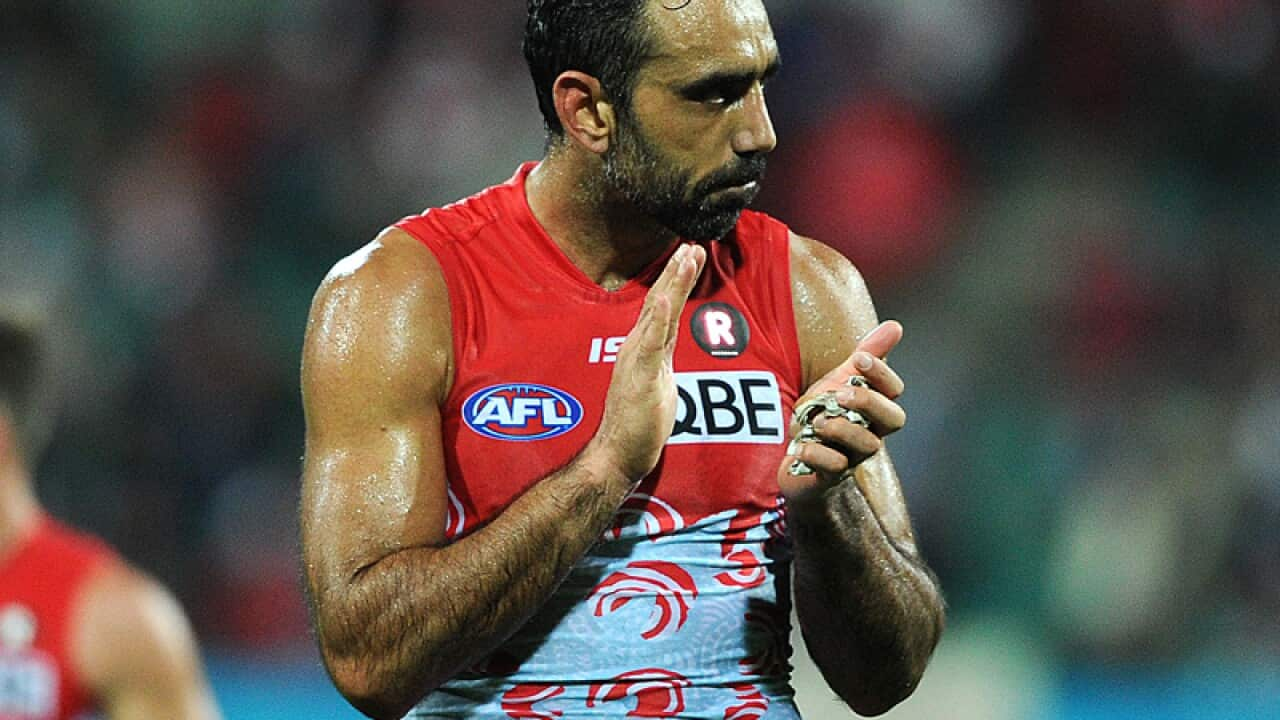But given the backlash surrounding Adam Goodes' Indigenous-inspired war cry, NITV News presenter Natalie Ahmat asks have we come as far as we'd like to believe?
Reading the reaction in the weekend newspapers and on social media to Adam Goodes’ Indigenous inspired goal celebration last Friday night, I was struck by an unsettling feeling of déjà vu.
The backlash from some sections of the mainstream media and football community took me back to 1993, to the moment St Kilda champion Nicky Winmar lifted his guernsey and proudly pointed to his skin in response to racist taunts from Collingwood supporters at Victoria Park.
It was the first time the AFL had seen anything like it.
Despite a number of Aboriginal players having played in the VFL/AFL to that point, including greats such as Graham 'Polly' Farmer, Syd Jackson, Barry Cable, Maurice Rioli, the Krakouer brothers and Michael McLean, Winmar was the first to stand up and openly and publicly embrace his cultural heritage, unafraid to say, "I'm black and I'm proud".
A champion, not only of the game, but for his people.
Looking back now, Winmar's gesture is considered a watershed moment for the AFL. A turning point for race relations in the game. But it wasn't without backlash at the time.
"I recall a deep feeling of pride as I watched these young fellas so passionately represent their team, families and communities"
The then-Collingwood President Allan McAllister infamously responded to the claims that his club, and its supporter base, were racist by inferring that Aboriginal players were welcome at the Magpies "as long as they conducted themselves like white people".
Fast forward 22 years and Adam Goodes, a proud Andyamathanha and Narungga man, Sydney Swans champion, dual Brownlow medallist and 2014 Australian of the Year, performs an Indigenous-inspired war cry to celebrate a goal he booted during the Indigenous round.
It's important to note that unlike Winmar in 1993, Goodes says his gesture was not in response to racist abuse from the crowd, but rather a celebration of his identity and culture.
Despite that, race is at the very centre of the ensuing debate surrounding his war cry.
The fact it was an "Indigenous"-inspired dance is what is fuelling this debate. If Goodes had run to the sideline and performed the Macarena, I'm certain it wouldn't still be dominating the media days later.
One of the first to weigh into the debate was Collingwood President Eddie Mcguire who commentated the match for Fox Footy. Despite getting into himself into hot water with his highly publicised “King Kong” comment directed at Goodes during Indigenous round two years ago, and despite undergoing cultural awareness training afterwards, McGuire questioned the appropriateness of Goodes goal celebration.
"We've never seen that [celebration] before and I don't think we ever want to see it again to be perfectly honest, regardless of what it is," he said.
McGuire's language was more subtle than his predessesor, but to many people - black and white- that I've spoken to these last few days, the underlying message was effectively the same as in 1993.
"I also felt a tinge of sadness, regret that I never had the chance to learn my peoples' dances when I was their age"
There were other critics there that night, in op-eds and on social media in the following days that labelled the war cry dance 'aggressive', 'threatening' or 'frightening'.
Goodes himself explained that the war cry he'd performed was inspired by the AFL's Under 16 Indigenous team, the Flying Boomerangs.
Just last year, I was lucky enough to do a story about the Boomerangs for NITV News during the National Championship. Standing behind my cameraman who was crouched on the ground in front of me, the players performed this dance for us, finishing centimetres from the camera lens.
I recall a deep feeling of pride as I watched these young fellas so passionately represent their team, families and communities. I also felt a tinge of sadness, regret that I never had the chance to learn my peoples' dances when I was their age.
What I did not feel that day was 'threatened' or 'frightened' despite being a whole lot closer to the war cry than those fans on Friday night, and having a whole team perform it. As for it being 'aggressive' – all I felt was the young players' pride and passion.
"What I did not feel that day was 'threatened' or 'frightened' despite being a whole lot closer to the war cry than those fans on Friday night, and having a whole team perform it"
So what exactly is scary about Adam Goodes standing up and performing an Indigenous-inspired dance during the Indigenous round? Why is a show of cultural pride so controversial to have fed the nation's media cycle for three, nearly four days straight?
Rather than criticising Adam Goodes, who like Winmar 22 years before him was a man unafraid to stand up and publicly declare "I'm black and I'm proud", perhaps the question critics really need to be asking itself is, what are we so afraid of?
My hope is Goodes’ war cry becomes a permanent fixture in future Indigenous rounds, and that 22 years from now is viewed in the same light as Nicky Winmar’s iconic stance.
Share

